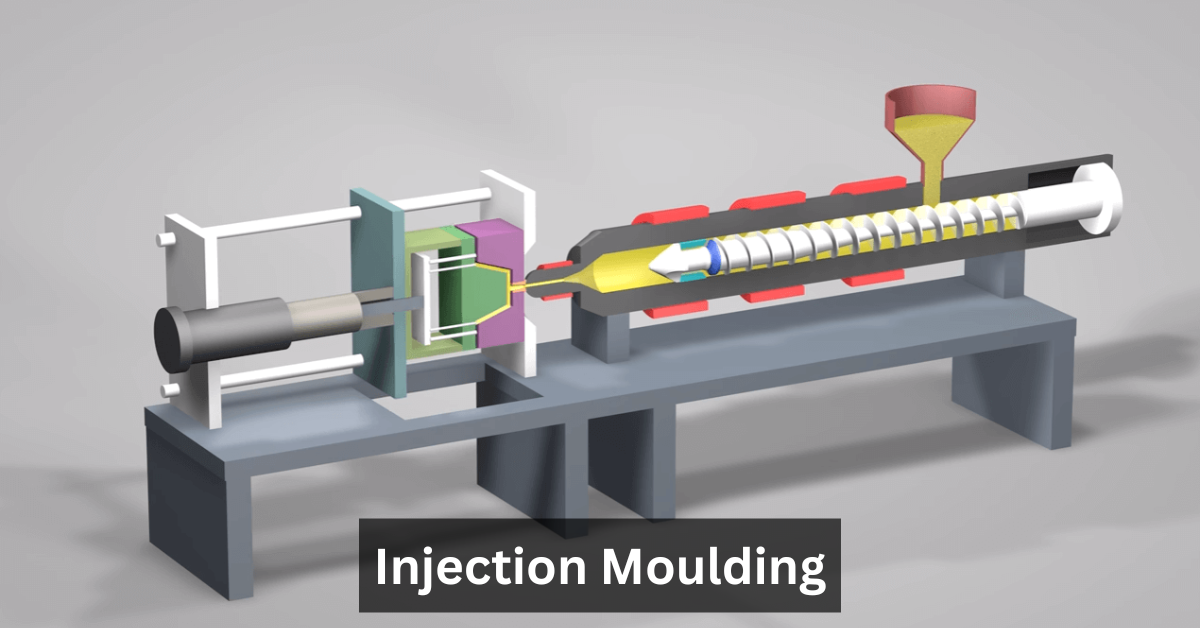Most manufacturers have a minimum order of 1,000 to 10,000 units due to high tooling costs. The method is most commonly associated with plastic Injection Moulding, where various thermoplastics such as Polypropylene (PP), ABS, Polycarbonate (PC), and HDPE are heated until they reach a liquid state and then forced into a mould under high pressure. Once cooled and solidified, the part takes on its final shape with high dimensional accuracy and surface finish. What makes Injection Moulding so powerful is its ability to replicate complex designs consistently over millions of cycles.
Are you looking to bring your product idea to life with speed, precision, and cost-efficiency? Whether you’re a startup entrepreneur or a seasoned manufacturer, understanding Injection Moulding is your gateway to scalable production success. This blog is your all-in-one guide—designed to answer your questions, simplify complex concepts, and empower you with expert knowledge. From choosing the right materials to partnering with the perfect mould supplier, we’ll walk you through every essential detail. Stick with us to discover how Injection Moulding can transform your production process and why it remains the backbone of countless industries worldwide.
The success of Injection Moulding lies in its versatility. From consumer electronics and automotive parts to medical devices and packaging solutions, Injection Moulding delivers efficiency, precision, and scalability. It’s a method that blends mechanical ingenuity with material science, shaping everything from a LEGO brick to sophisticated aerospace components.
Injection Moulding dates back to the 1870s, when John and Isaiah Hyatt secured the first patent for moulding celluloid, marking its historic origin. What began as a basic process for combs and buttons evolved dramatically in the 20th century. The invention of the reciprocating screw injection machine in the 1950s marked a turning point. Modern-day machines from Arburg, Engel, KraussMaffei, and Milacron now incorporate advanced digital controls, automated feeders, and high-efficiency clamping systems.
With growing industrial needs and environmental regulations, Injection Moulding has adapted to offer eco-friendlier materials and more energy-efficient technologies. Industry bodies like the British Plastics Federation and SPI help regulate and support growth, aligning practices with global standards like ISO 9001 and ISO 20430.
Injection Moulding powers nearly every manufacturing sector. In the automotive industry, it is used to fabricate interior panels, dashboards, handles, and complex under-the-hood components. Medical technology depends on Injection Moulding to produce sterile, disposable parts such as syringes, pill containers, and surgical instruments. In consumer electronics, sleek and compact designs for smartphones, remotes, and laptops are made possible by Injection Moulding’s tight tolerances.
In the packaging sector, Injection Moulding produces everything from bottle caps to tamper-evident seals. And let’s not forget toys—LEGO bricks, possibly the most iconic example of precision Injection Moulding, demonstrate just how far the process can go in achieving repeatability and excellence.
How Injection Moulding Works
Step-by-Step Process of Injection Moulding
The Injection Moulding process follows a precise and consistent series of steps. First, plastic granules are fed from a hopper into a heated barrel, where a screw rotates to melt the plastic through friction and external heaters. The resulting polymer melt is then pushed forward under intense injection pressure and shot into a mould cavity through a sprue, runner system, and gate design that ensure even distribution.
Once inside the mould, the material begins to cool during a carefully timed cooling cycle. Proper mold temperature control is crucial here to avoid internal stresses or surface defects. Finally, ejector pins push the finished part out of the mould, and the cycle restarts—sometimes within seconds, depending on the cycle time and part complexity.
Main Components of an Injection Moulding Machine
An Injection Moulding machine is made up of several key components:
- Injection Unit: Melts and injects the material.
- Clamping Unit: Applies and maintains clamping force to hold the mould shut.
- Mould Tooling: The custom-shaped metal mould that forms the final product.
Today’s machines from companies like Sumitomo (SHI) Demag and Husky Injection Molding often feature smart technologies like real-time monitoring and adaptive feedback systems, which enhance quality control and reduce energy consumption.
Role of Heat, Pressure, and Cooling in Moulding
The interplay of temperature, pressure, and cooling defines the quality of any injection moulded product. Melt flow index plays a critical role in determining the flowability of the polymer. Too low, and the material won’t fill the mould completely. Too high, and it may cause flash, burns, or dimensional inaccuracies. Achieving optimal injection pressure and maintaining proper mould temperature ensures a strong bond between layers and smooth surface finish. Efficient cooling channels reduce cycle times and improve production rates—crucial factors for cost-effectiveness.
Materials Used in Injection Moulding
Common Thermoplastics (e.g., PP, ABS, Nylon)
Most Injection Moulding projects rely on thermoplastics due to their ability to be melted and reshaped repeatedly. Common materials include:
- Polypropylene (PP): Lightweight, chemical-resistant.
- ABS: Strong, impact-resistant, ideal for electronics.
- Nylon: Durable, wear-resistant, used in gears and mechanical parts.
These materials offer flexibility, affordability, and ease of processing, making them the first choice in many commercial applications.
Engineering Plastics for High-Performance Applications
For demanding environments like automotive or aerospace, engineering plastics provide superior mechanical strength, thermal stability, and electrical resistance. Examples include Polycarbonate (PC) for clear housings and PBT (Polybutylene Terephthalate) for electrical connectors. These materials allow precision moulding for parts where failure is not an option.
Biodegradable and Sustainable Alternatives
As sustainability becomes essential, biodegradable polymers such as PLA (Polylactic Acid) and bio-based PE/PP are entering the scene. These alternatives aim to reduce environmental impact without sacrificing the efficiency of Injection Moulding. They are especially popular in single-use items like cutlery, packaging, and agricultural products.
Types of Injection Moulding Techniques
Standard Injection Moulding
This is the most widely used method, ideal for high-volume production of uniform parts. It’s used across all industries due to its low cost-per-part and reliability.
Overmoulding and Insert Moulding
Overmoulding bonds multiple materials in one cycle, such as rubber grips over hard plastic. Insert moulding places pre-fabricated parts—like metal pins—into the mould before injecting plastic, creating strong, integrated assemblies.
Gas-Assisted and Micro Injection Moulding
Gas-assisted Injection Moulding creates hollow sections inside thick parts, reducing material use while maintaining strength. Micro Injection Moulding is essential for making miniature parts used in medical devices and electronics, where tolerances are extremely tight.
Multi-Shot (2K) Moulding Techniques
This advanced method injects two or more materials in sequence into the same mould. It enhances product aesthetics and functionality—for example, making toothbrushes with soft and hard layers in one cycle.
Advantages and Disadvantages of Injection Moulding
Benefits: Speed, Precision, Scalability
The biggest advantage of Injection Moulding is scalability. Once the mould is created, production runs are incredibly fast. Complex parts with intricate undercuts, ribs, or threading can be created with supreme accuracy. The process also reduces human error, ensures flash-free finishes, and improves product consistency.
Limitations: Cost, Design Complexity, Lead Time
The main drawbacks involve tooling costs and lead times. Designing and producing a custom mould tool can be expensive and time-consuming. Additionally, making design changes after tooling is manufactured is often impractical. These limitations make Injection Moulding best suited for mass production.
Injection Moulding Tooling and Design Considerations
Designing Effective Mould Cavities and Cores
A great product begins with a well-engineered mould cavity. Precision in cavity layout ensures uniform material distribution and minimizes waste. Incorporating vents, cooling lines, and well-balanced runner systems results in superior product quality.
Importance of Draft Angles, Wall Thickness, and Ribs
Draft angles prevent parts from sticking during ejection. Consistent wall thickness prevents warping and improves flow. Ribs provide strength without increasing bulk—crucial in lightweight designs.
Cooling Channels, Ejector Pins, and Gate Design
Efficient cooling channels reduce cycle time, while properly placed ejector pins ensure smooth part release. Optimized gate design determines how molten plastic enters the mould, affecting flow, finish, and part integrity.
Injection Moulding Cost Breakdown
Tooling and Mould Costs
The mould itself is the biggest upfront cost. Made from steel or aluminum, it includes multiple cavities, cooling systems, and alignment features. Complex designs or multi-shot moulding significantly increase this cost.
Material and Machine Time Expenses
Costs vary depending on the Injection Moulding materials, machine shot size, and cycle time. High-performance plastics cost more, but often reduce overall weight or improve longevity.
Cost Optimisation Strategies for Mass Production
Strategies include using family moulds, reducing cycle time, and recycling runner scraps. Working with expert Injection Moulding manufacturers also helps minimize waste and maximize output.
Common Defects in Injection Moulding and How to Fix Them
Warping, Flash, Sink Marks, Short Shots
Common defects in Injection Moulding include:
- Warping: Uneven cooling.
- Flash: Excess plastic around the edges.
- Sink Marks: Depressions due to insufficient fill.
- Short Shots: Incomplete filling of the mould.
Causes and Preventive Measures
These issues are often caused by incorrect injection pressure, poor mould design, or uneven mold temperature. Preventive measures include adjusting machine settings, redesigning the part, or enhancing cooling systems.
Quality Control and Inspection Techniques
Using automated inspection systems, in-line sensors, and scientific moulding methods ensures consistent quality. These approaches help detect issues in real-time and reduce production waste.
Injection Moulding in Different Industries
Automotive and Aerospace Applications
From interior trims to engine components, Injection Moulding delivers durable, lightweight solutions for the transportation industry. Aerospace benefits from high-tolerance and flame-retardant polymers.
Consumer Electronics and Medical Devices
Precision and hygiene are critical in these industries. Cleanroom-compatible Injection Moulding machines produce sterile devices, while electronics require EMI shielding and compact design.
Packaging and Toys (e.g., LEGO)
Everyday items like shampoo caps or LEGO sets are the result of high-speed Injection Moulding lines. It’s all about mass production, durability, and consistent appearance.
Injection Moulding vs. Other Manufacturing Methods
Comparison with 3D Printing
3D printing offers flexibility for prototypes but lacks the speed and scalability of Injection Moulding for final production.
Comparison with CNC Machining and Die Casting
CNC machining excels in metal work but generates more waste. Die casting is suitable for metals but lacks the versatility and speed of plastic Injection Moulding.
Choosing the Right Method for Your Project
For complex plastic parts in large quantities, Injection Moulding remains the best choice due to low per-part cost and high quality.
Future Trends in Injection Moulding
Smart Manufacturing and Industry 4.0 Integration
Modern factories use sensors and real-time data to optimize every step of the Injection Moulding process. Industry 4.0 is making manufacturing smarter, faster, and more reliable.
Eco-friendly Moulding and Recycling
Closed-loop systems and biodegradable plastics are helping reduce waste. Injection Moulding Company is evolving toward greener practices without compromising performance.
Use of AI and Automation in Mould Design
AI tools are now used to simulate mould flow, predict defects, and optimize cavity layout, reducing trial-and-error and development costs.
Choosing the Right Injection Moulding Partner
Factors to Consider When Selecting a Manufacturer
Look for partners with proven experience, high-end machinery, and certifications. Their understanding of tooling, materials, and process optimization makes all the difference.
Top Global Injection Moulding Companies
Reputed names include Arburg, Engel, Milacron, Sumitomo (SHI) Demag, and Husky—each known for innovation and reliability.
Certifications and Standards (ISO 20430, ISO 9001)
These global standards ensure machines are safe, consistent, and perform to specifications, giving customers confidence in the final product.
Conclusion
Injection Moulding is a cornerstone of modern manufacturing. Its ability to produce complex, durable, and cost-effective parts at scale makes it indispensable. Whether you’re launching a new product or optimizing an existing one, Injection Moulding delivers performance, efficiency, and innovation with every cycle. Embrace this technology, and you’re not just creating parts—you’re building future-ready solutions.
Frequently Asked Questions
How long does it take to make a mould?
Creating a custom mould typically takes 4 to 12 weeks, depending on complexity.
Can recycled plastic be used in Injection Moulding?
Yes, but the melt flow index and mechanical properties must be carefully evaluated to ensure consistent results.
What is the lifespan of an injection mould?
A steel mould can last for millions of cycles with proper maintenance.
Stay in touch to get more updates & alerts on Erome! Thank you



